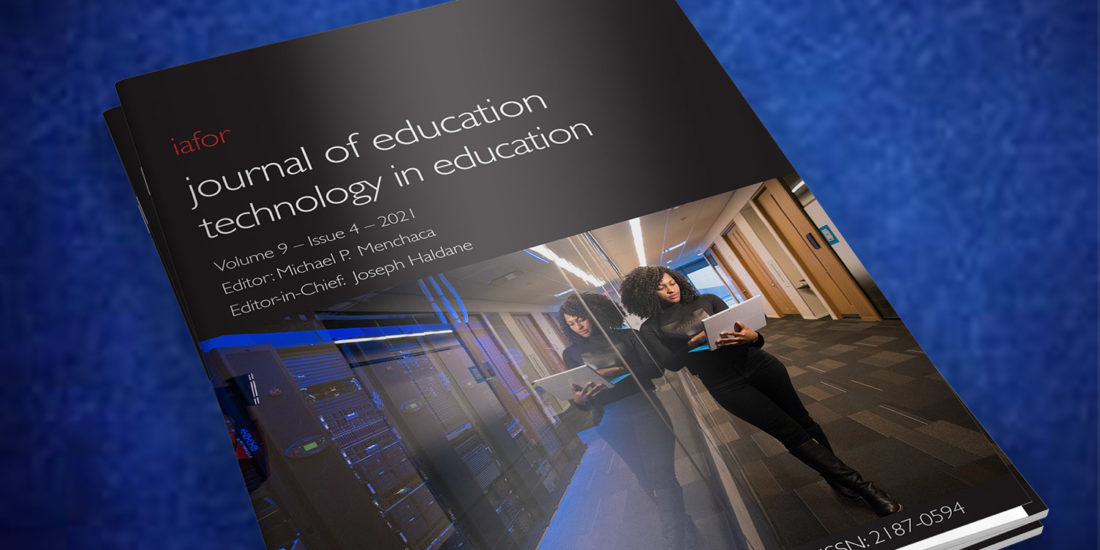Welcome to the Technology in Education Issue
IAFOR Journal of Education: Volume 9 – Issue 4 – Technology in Education
Editor: Michael P. Menchaca
Associate Editor: Daniel L. Hoffman
Editor-in-Chief: Joseph Haldane
Published: August 27, 2021
ISSN: 2187-0594
https://doi.org/10.22492/ije.9.4
We are delighted to announce that the IAFOR Journal of Education: Technology in Education issue is now published. This is the Journal’s second recent offering in the specialized area of educational technology. The Journal overall remains committed to inter-disciplinary, international, diverse articles and this issue is no exception. The seven articles included represent: (a) research in both higher education and secondary settings, (b) a mixture of design-based, qualitative, quantitative, and mixed-methods approaches, and (c) five different countries. The articles cover diverse areas such as: artificial intelligence, teacher education, documentary film-making, language learning, mobile learning, virtual manipulatives, and learning task selection.
When perusing this issue, in particular, please note the authors’ incorporation of theoretic or conceptual foundations to help guide their questions and conclusions. As editors, we receive many quality manuscript submissions whose main shortcoming is a lack of foundational theory. Consider framing your research with theory when submitting manuscripts.
Here is a summary of each article in this issue.
Article 1
In the first article, “Teaching during a pandemic: Elementary candidates’ experiences with engagement in distance education,” Monica Gonzalez Smith and Nicole Schlaack conducted an interpretive phenomenological study of the lived experience of teacher candidates promoting student engagement while delivering emergency remote teaching in the Pacific Southwest during the pandemic. Conclusions provided by the study included that teacher candidates need more support with questioning, assessment, and technology tools to keep students engaged and that teacher preparation programs need to provide teacher candidates opportunities to practice engagement strategies in distance settings.
https://doi.org/10.22492/ije.9.4.01
Article 2
Onur Oymak and Feral Ogan-Bekiroglu, in their article, “Comparison of Students’ Learning and Attitudes in Physical versus Virtual Manipulatives using Inquiry-Based Instruction,” employ a pre-post comparison design in a Turkish secondary setting to study the effects of virtual versus physical manipulatives on student learning. An interesting conclusion was that students had fewer measurement errors when relying on virtual manipulatives.
https://doi.org/10.22492/ije.9.4.02
Article 3
Finland’s Stina Westman, Janne Kauttonen, Aarne Klemetti, Niilo Korhonen, Milja Manninen, Asko Mononen, Salla Niittymaki, and Henry Paananen use a convergent parallel mixed-methods design in their research on using artificial intelligence to support career guidance in higher education. Their study looked at the viewpoints of students and career guidance staff while they experienced the inclusion of AI for career guidance. The study indicated AI can help support the agency of students to prioritize, choose, and consider important decisions for their professional lives.
https://doi.org/10.22492/ije.9.4.03
Article 4
In the fourth article, “Five tips from filmmakers: An online instructional module for documentary film research,” Patsy Iwasaki, an instructor and filmmaker from Hawaii, utilized convergent mixed-methods to study how an instructional module on documentary filmmaking informed by experts provided an educational foundation for appropriate subject research and data collection among higher education students. The study revealed that providing information and data literacy helped scaffold creativity in the arts while adhering to high standards for research.
https://doi.org/10.22492/ije.9.4.04
Article 5
Seohyun Choi, Jaewon Jung, and Dongsik Kim’s article, “The effects of task selection approaches to emphasis manipulation on cognitive load and knowledge transfer,” used an experimental methodology to study student task selection in a secondary school in South Korea. The study suggested an outside agent (such as an instructor or computer) can provide better task selection by emphasizing only areas of weakness compared to students having to choose for themselves among a list of tasks that might provide redundant knowledge.
https://doi.org/10.22492/ije.9.4.05
Article 6
In the sixth article, “Machine translation in the language classroom: Turkish EFL learners’ and instructors’ perceptions and use,” Murat Ata and Emre Debreli compared student versus faculty perceptions of the use of Online Machine Translation (e.g., Google Translate) for learning English as a Foreign Language in higher education. Their findings suggested institutions should establish policies regarding the use of OMT tools, specifically to guide students in language learning as well as to better understand the ethics of using such tools.
https://doi.org/10.22492/ije.9.4.06
Article 7
Finally, Eunice Ofori and Barbara Lockee’s article, “Next generation mobile learning: Leveraging message design considerations for learning and accessibility,” implemented a design and development methodology to establish guidelines for mobile learning (mLearning) in higher education in the U.S. Their guidelines were informed from prior research on message design and Universal Design for Learning and could assist in creating optimal mLearning instruction.
https://doi.org/10.22492/ije.9.4.07
Overall, these articles provide appropriate direction for incorporating complex technology in educational settings. We trust you will find the articles as useful as they are enjoyable to read.
Editorial team, IAFOR Journal of Education: Technology in Education
Michael P. Menchaca, Editor, and Daniel L. Hoffman, Associate Editor
IAFOR Journal of Education: Technology in Education
[email protected]

